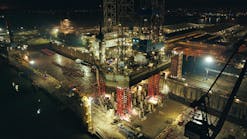BP Amoco says the most likely develop ment scenario for its huge deepwater Crazy Horse prospect is a Spar, which is a deep draft floating column tethered to the seabed, with or without a spread mooring array. The company says its subsalt find is the largest ever made in the Gulf of Mexico - an estimated 1 billion boe field. The reservoir appears to be mostly oil, with associated gas.
The very large Crazy Horse field is isolated from other prospects or producing fields, and far from oil pipelines.
Steven Peacock, GOM Exploration Vice-President, cautioned that development planning is in the very early stages, and while no decision have been made, it appears that a Spar is the likely route to development. Developers face a number of challenges:
- Crazy Horse is in 6,000 ft water depth, clearly too deep for more traditional development solutions, and too deep for a tension leg platform.
- The field also is far from other producing fields or even prospective producers, meaning that development will face major financial obstacles.
The Transocean 534 drilled the Crazy Horse discovery well. It or the new Discoverer Enterprise drillship will drill an appraisal well in the forth quarter.
The BP Amoco spokesperson declined comment on the difficulty of drilling the ultra-deepwater well. However, other industry sources indicate that Crazy Horse's future development wells might have to be drilled differently, or with riser modifications, in order to preserve the wells for development purposes.
More infrastructure
Peacock said the Crazy Horse deepwater development could open the door to establishing more infrastructure in that sector of the US Gulf of Mexico.
He admitted that a floating production, storage, and offloading (FPSO) vessel was also on the possibilities list, because of the lack of infrastructure.
He said it is too early in the MMS FPSO appraisal process for an FPSO to be a serious contender as yet. At present, there are no FPSOs in the US Gulf and the acceptance of one will face the same environmental obstacles that tankers do.
Discovery specifics
Transocean's Transocean 534 drillship drilled the Mississippi Canyon 778 discovery well to a total depth of about 25,000 ft, encountering several thousand feet of salt body in the process.
The entire Crazy Horse reservoir is believed to underlie 6,000 ft water depth on Mississippi Canyon blocks 776, 777, and 778. The field lies in what is known as the Boarshead Basin, 125 miles southeast of New Orleans.
The field is located about two lease blocks distance away from Shell's Mensa field, a high volume gas development. BP Amoco operates Crazy Horse, and holds a 75% share. Mobil owns the remaining 25%.
A BP Amoco spokesman declined to reveal oil grade specifics or well test data, but did say the operator possessed very encouraging information from a high-quality seismic data set over the area, as well as well core data and good pressure data from the well.
Because Crazy Horse is mostly oil, tieback to Mensa facilities is not at all likely. Mensa is a recoverable 720 Bcf subsea development, itself tied back a record 68 miles to West Delta 143.
Future plans
A BP Amoco spokesperson said the operator will probably use either the Transocean 534 or Transocean Enterprise deepwater drillships to drill a Crazy Horse appraisal well in the fourth quarter of 1999.
The appraisal well is intended to refine the reserves estimate and provide more reservoir data. "The well is clearly going to be commercial," said Peacock.
Once the information from the well is available, BP Amoco will be able to make more specific plans and create a development timetable. In the meantime, BP Amoco declines to speculate.
BP Amoco has indicated that the Crazy Horse development may serve as infra structure for future developments as well. Discoveries are sparse in the area as yet, though that may change. The nearest pipeline is the tieback from Mensa, which is unsuitable for oil.





